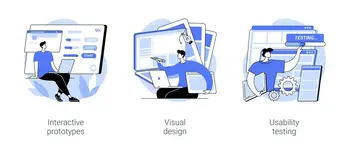
Table of contents
Interactive technology is a big part of our lives now. It has changed the way we talk to each other and the world around us. Phones and social media make it easy to connect, talk, and share things with others. But the effect of interactive technology on society is a complicated thing. We need to study it more.
A recent
study
found that people spend over 6 hours a day using digital media, with more than half of that time on their phones. This shows how important interactive technology is in our lives. But it’s not all good news. Interactive technology has also led to problems like cyberbullying, social isolation, and addiction.
As interactive technology keeps changing, it’s important to study its effects on people. The United Nations report “
The Impact of Digital Technologies
” and BBVA OpenMind’s “
The Impact of the Internet on Society: A Global Perspective
” are two good places to start. By understanding the good and bad sides of interactive technology, we can make better choices about how to use it.
Interactive Technology in the Modern Society

In the world today, interactive technology is very important. It has changed the way we live, work, and communicate. This article will talk about how interactive technology affects our lives and what the benefits and challenges are.
1. Revolutionising Communication
Interactive technology has changed the way we communicate by breaking down the walls of distance and making it possible to connect instantly. Social media sites, messaging apps, and video conferencing tools have made it possible for us to share ideas, news, and personal experiences in real-time. However, this has also led to concerns about digital privacy and the authenticity of online relationships.
2. Reshaping Work Dynamics
The workplace has changed a lot because of technology. People can now work from home using digital tools that make it easy to collaborate. This has changed the way people work and has made it more flexible. But it has also made it harder to stay connected with co-workers and to make sure everyone has the same opportunities.
3. Entertainment in the Digital Age
Interactive technology has changed the way we entertain ourselves. Augmented reality (AR) and virtual reality (VR) have made games and stories more immersive, by letting users experience them in a virtual world. Streaming services have replaced traditional TV, by giving people access to personalized, on-demand content. The combination of technology and entertainment is constantly changing, and it promises to offer even more interactive and personalized experiences in the future.
4. Transforming Everyday Living
Interactive technology is making our lives easier and more efficient. Smart devices and the Internet of Things (IoT) are connecting our homes so that we can control and monitor them with our smartphones. From smart thermostats that can automatically adjust the temperature to voice-activated assistants that can turn on lights and play music, these innovations are making our lives more convenient.
5. Navigating the Digital Landscape
Interactive technology has changed how we find our way around. Navigation apps and location-based services give us real-time information and directions, making travel more fun and easier. Technology-driven data analysis has led to smart cities, where infrastructure and services are improved using data.
6. Challenges and Considerations

Interactive technology has many good things, but it also has some problems. One problem is that it can be hard to keep your information safe. People can steal your data or hack into your computer. Another problem is that not everyone has access to interactive technology. This is called the digital divide. We need to make sure that everyone has a chance to use interactive technology.
We need to find a way to use interactive technology without having these problems. We need to be careful about what information we share online. We also need to make sure that everyone has access to interactive technology.
Interactive technology is changing the world in many ways. It is changing the way we communicate, work, and play. We need to be careful about how we use it, but it also has the potential to make our lives better.
Here are some specific examples of how interactive technology is being used:
- Interactive whiteboards are being used in classrooms to help students learn.
- Virtual reality is being used to train surgeons and pilots.
- Social media is being used to connect people all over the world.
- Online games are being used to entertain and educate people.
Interactive technology is a powerful tool that can be used for good or bad. It is up to us to use it responsibly and make sure that everyone has a chance to benefit from it.
The Benefits of Interactive Technology

Interactive technology has helped people in many ways, making things more efficient and engaging. This section will look at some of the most important benefits of interactive technology.
i. Increased Efficiency
Interactive technology can make things more efficient. For example, AI-powered technologies can help doctors diagnose diseases and save lives. In education, virtual learning environments and online courses make it possible for people to learn from anywhere. Smartphones make it easy to stay in touch with people all over the world.
A report by the
McKinsey Global Institute
says that using digital technologies in the workplace could increase global GDP by $1.5 trillion in the next 10 years. This shows how interactive technology can help businesses be more productive and efficient
Here are some specific examples of how interactive technology is being used to improve efficiency:
- AI-powered robots are being used in manufacturing to perform tasks that are dangerous or repetitive for humans.
- Virtual reality is being used to train surgeons and other medical professionals.
- Online learning platforms are making it possible for people to get a degree or certificate without having to travel to a traditional campus.
- Telemedicine is allowing doctors to see patients from anywhere in the world.
Interactive technology is still in its early stages, but it has the potential to revolutionize many industries and make our lives more efficient.
ii. Improved Engagement

Interactive technology has helped to improve engagement in many different fields. For example, art and science museums are using interactive exhibits to get visitors involved and make their learning experience more fun. Schools are using interactive programs and games to make learning more enjoyable by keeping students engaged.
A
study
found that interactive technology can increase engagement and motivation in learning. The study found that students who used learning technology with interactivity were more likely to finish their assignments on time and get better grades.
iii. Enriching Communication
Interactive technology has changed the way people communicate. Now, people can connect with each other instantly, even if they are far apart.
Social media, messaging apps, and video conferencing tools make it easy for people to interact. This helps people stay in touch with friends and family, and it also helps people work together on projects.
This has made the world feel more connected. People can now learn about different cultures and ideas from all over the world.
iv. Personalised Learning and Education

In school, personalized learning is a new way to teach. Classroom technology helps teachers to make learning plans that enhance student engagement. These plans are based on what the student already knows and how they learn best. There are many learning technologies; educational technology tools, and interactive games that help students learn at their own pace. This makes it easier for everyone to learn, no matter how they learn best.
Virtual classrooms and distance learning are also becoming more popular. These allow students to learn from home or anywhere else with an internet connection. This is a good option for students who have to miss school or who want to learn at their own pace.
Personalized learning, virtual classrooms, and distance learning are all ways to make education more accessible and effective for everyone.
v. Advancements in Healthcare
Interactive technology has changed healthcare by making it possible to monitor patients from a distance, see doctors without leaving home, and give each patient the care they need.
Remote patient monitoring:
Wearable devices and apps can track a person’s health data, such as heart rate, blood pressure, and blood sugar levels. This data can be sent to a doctor or nurse, who can then monitor the patient’s health and make sure they are getting the care they need.
Telemedicine:
This is when a doctor or other healthcare provider sees a patient over the Internet. This can be done through video chat, phone calls, or text messages. Telemedicine can help patients get the care they need without having to travel to a doctor’s office.
Precision medicine: This is when doctors use a patient’s individual genetic information to choose the best treatment for them. This can help doctors give patients more personalized care.
v. Enhanced Entertainment Experiences

The entertainment world has changed a lot because of interactive technology. Augmented reality (AR) and virtual reality (VR) have made games more realistic and changed the way stories are told. Streaming services let people watch what they want when they want. This new interactivity makes people more involved in entertainment and blurs the line between watching and doing.
vi. Improving Productivity and Efficiency
The development of interactive technology has made work more productive and efficient in many ways. For example, automation can do repetitive tasks without making mistakes, and data analysis can help businesses make better decisions. Artificial intelligence (AI) can also be used to improve efficiency, such as by automating customer service tasks.
Interactive technology has also made it possible for people to work together more easily, even if they are not in the same place. This is because collaborative tools like video conferencing and online chat make it easy to communicate and share information. This can help teams to work more effectively, even if they are spread out across different time zones.
Overall, interactive technology has had a positive impact on productivity and efficiency in many industries. It has made work more efficient by automating tasks, analyzing data, and using AI. It has also made it easier for people to work together, which can further improve efficiency.
vii. Empowering Creativity

Interactive technology has given people the ability to express their creativity in new ways. Modern digital platforms have many tools for making graphics, music, and videos. This has made creative expression more accessible to everyone. Now, artists can share their work with people all over the world and make money from their skills.
For example, Seth Godin’s free online book “Unleashing the Ideavirus” was downloaded by over a million people. This shows that anyone can create and share their work with a global audience, no matter where they live.
Interactive technology has made it possible for people to express their creativity in ways that were never before possible. This is a great thing for artists and for everyone who enjoys art.
Here are some specific examples of how interactive technology has democratized creative expression:
- Graphics: Software like Adobe Photoshop and GIMP make it easy for anyone to create professional-quality graphics.
- Music: Digital audio workstations like FL Studio and Ableton Live allow musicians to record, produce, and mix music without any special training.
- Video: Video editing software like Adobe Premiere Pro and Final Cut Pro make it possible to create high-quality videos with ease.
These are just a few examples of how interactive technology has made creative expression more accessible to everyone. With the right tools, anyone can express their creativity and share it with the world.
viii. Enhancing Accessibility
New technology has made it easier for people with disabilities to use computers and other devices. Tools like screen readers and voice recognition software help people who can’t see or hear well to use computers. Other devices, like wheelchairs and hearing aids, help people with physical disabilities.
These new technologies have made it possible for people with disabilities to participate in more activities. They can go to school, get a job, and live independently. Technology has helped to make the world a more inclusive place for everyone.
The Impact on Society

Interactive technology has changed the way people talk to each other and the world around them. There are many good things about these technologies, but there are also some bad things that we need to think about. This section will look at how interactive technology has affected society, especially young people and people who are not as rich.
1. Inequality
One of the biggest problems with interactive technology is that it is not equally available to everyone. The
Pew Research Center
found that only about half (58%) of households with an annual income of less than $30,000 have access to broadband internet, compared to about nine out of ten (94%) households with an annual income of $75,000 or more. This gap in access is called the “digital divide.”
The digital divide has a big impact on education, healthcare, and economic opportunities. People without access to interactive technology are at a disadvantage in school because they cannot use online resources or participate in online classes. They also have less access to healthcare information and services, and they may have difficulty finding jobs that require the use of technology.
We need to do more to close the digital divide. This means making sure that everyone has affordable access to broadband internet and other interactive technologies. We also need to provide training and support so that people can use these technologies effectively.
2. Younger Generations
Interactive technology has had a big effect on younger people. These technologies can improve education and communication, but they can also lead to problems like addiction, cyberbullying, and fewer social skills.
A
report
by Common Sense Media says that kids between 8 and 12 spend 6 hours a day using interactive technology, and teenagers spend 9 hours a day. This much technology use has been linked to problems like worse school grades and more depression and anxiety.
To fix these problems, we need to make sure that everyone has equal access to interactive technology and that young people are taught how to use it responsibly.
Overall, interactive technology has had a big impact on society. It’s important to know about the potential problems and work to fix them. By making sure everyone has access to these technologies and teaching people how to use them responsibly, we can make sure that everyone can enjoy the benefits of interactive technology.
The Effects on Work and Business
Interactive technology has had a big effect on the way people work and businesses work. Here are some parts that show some of the effects:
(a) Automation

Automation is when machines do work that was done by people before. A
report
by McKinsey Global Institute says that up to 800 million jobs could be lost to automation by 2030. But automation can also create new jobs and make businesses more efficient.
For example, businesses use chatbots to answer customer questions. This can free up human customer service representatives to work on more complex problems. Automation can also be used in manufacturing to make products more quickly and accurately. And it can be used to analyze data to help businesses make better decisions.
Overall, automation is a powerful tool that can have a big impact on work and business. It is important to use automation wisely to create new jobs and improve efficiency.
(b) Gig Economy
The gig economy is a way of working where people do short-term jobs or freelance work instead of having a permanent job. A
report
by Intuit says that 43% of the US workforce will be freelancers by 2020.
Interactive technology has made it easier for people to find freelance work and for businesses to hire freelancers. Platforms like
Upwork
and
Fiverr
connect businesses with freelancers from all over the world. The gig economy can give workers more flexibility and businesses can save money.
However, the gig economy also has some problems. Workers may not have job security or benefits like health insurance. It’s important for businesses to make sure that their freelance workers are treated fairly and have access to benefits.
(c) Cybersecurity and Cybercrimes
As businesses use more technology, it is more important to protect their computers and data from cybercrime. Cybercrimes like data breaches and hacking can cause a lot of damage to businesses. According to a
report
by IBM, the average cost of a data breach in 2021 was $4.62 million, up from $3.86 million in 2020.
Businesses need to take cybersecurity seriously and invest in ways to protect their data and networks. This includes training employees on cybersecurity best practices, using strong passwords and encryption, and regularly updating software and systems.
(d) Digital Advances
Interactive technology has led to many new ways for businesses to work. For example, cloud computing lets businesses store and use data from anywhere. This makes it easier for businesses to work together even when they are not in the same place.
Other new technologies include artificial intelligence, blockchain, and the Internet of Things (IoT). These technologies have the potential to change many industries, such as healthcare, finance, and transportation.
Interactive technology has had a big impact on work and business. It can be challenging to keep up with the latest technology, but it is important for businesses to do so in order to be efficient and productive. Businesses should also invest in security measures to protect their data and networks.
The Influence on Daily Life and Well-being

Interactive technology is everywhere in our modern world. We use smartphones, computers, and social media all the time. People have been arguing about how these technologies affect our daily lives and our mental health. This section will talk about how interactive technology can affect depression, well-being, lifestyle, and happiness.
i. Depression and Well-being
Excessive use of interactive technology can make people feel bad and not happy. A study by the University of Southern California found that people who used the internet more often for social media had more depression and worry. In China, where many people use the internet, the government knows that too much screen time is bad and has made rules to stop it.
Interactive technology can also be good for mental health. For example, music streaming services can make people feel better and help them not be as depressed. Computer scientists are also studying how to use computers to find people who are depressed and help them feel better.
ii. Lifestyle and Happiness
Interactive technology has had a big impact on how we live and how happy we are. E-commerce and online shopping have made it easier to buy things, which is more convenient and satisfying. But it has also led to more credit card fraud and data breaches.
Technology has also helped people make better choices about their health and the environment. For example, there are apps that track exercise and diet, and computer networks can help businesses use less energy.
During the COVID-19 pandemic, interactive technology has been important for staying connected with friends and family and for working from home. But too much screen time can make people feel lonely and isolated.
Overall, interactive technology has had a big impact on our lives. It can improve our mental health, lifestyle, and happiness, but it can also have negative effects. We need to find a balance between the benefits and drawbacks of interactive technology to live healthy and fulfilling lives.







